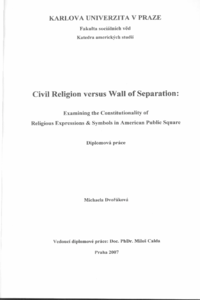Civil Religion versus Wall of Separation: Examining the Constitutionality of Religious Expressions & Symbols in American Public Square
Civil Religion versus Wall of Separation: Examining the Constitutionality of Religious Expressions & Symbols in American Public Square
diplomová práce (OBHÁJENO)

Zobrazit/
Trvalý odkaz
http://hdl.handle.net/20.500.11956/997Identifikátory
SIS: 2674
Kolekce
- Kvalifikační práce [17123]
Autor
Vedoucí práce
Oponent práce
Fojtek, Vít
Fakulta / součást
Fakulta sociálních věd
Obor
Americká studia
Katedra / ústav / klinika
Katedra severoamerických studií
Datum obhajoby
27. 6. 2007
Nakladatel
Univerzita Karlova, Fakulta sociálních vědJazyk
Angličtina
Známka
Výborně
RESUMÉ První dodatek Ústavy Spojených států amerických mj. stanovuje, že "Kongres nesmí vydávat zákony zavádějící nějaké náboženství nebo zákony, které by zakazovaly svobodné vyznávání nějakého náboženství Jádrem sporu se stala především první část dodatku, tzv. zaváděcí klauzule (Establishment Clause). Zatímco stoupenci doslovné interpretace zastávají názor, že Kongres nesmí založit státní církev, ale může náboženství podporovat, preferují jiní širší interpretaci, tj. úplný zákaz zasahování státu do náboženských záležitostí. Ústavní soud se ve svém prvním velkém případě souvisejícím se zaváděcí klauzulí (Everson v. Board of Education, 1947J jednomyslně vyslovil pro interpretaci širší. Ve svém rozsudku se odvolal na Thomase Jeffersona a jeho "dělící zed'" (wall of separation), zábranu či bariéru mezi církví a státem, jež má dle výroku soudu zůstat "vysoká a nedobytná". Myšlenka "dělící zdi", jíž Jefferson použil v dopise baptistům z Danbury (1802), byla přijata jako komentář к prvnímu dodatku Ústavy, který - přes množství odpůrců - značně přispěl к vytlačení náboženských projevů z veřejné sféry. Předložená práce je postavena na paradoxu existence již zmíněné "vysoké a nedobytné""dělící zdi" mezi církví a státem na straně jedné a četných náboženských praktik a symbolů v americké společnosti na straně druhé....
INTRODUCTION The First Amendment to the Constitution of the United States affirms that "Congress shall make no law respecting an establishment of religion, or prohibiting thefree exercise thereof.... It was primarily the first part of the provision, commonly referred to as the Establishment Clause that has become a major point of contention and debate among justices and legal scholars alike. While advocates of textual interpretation maintain that Congress is not allowed to establish a national church but can provide aid to religion on a nondiscriminatory basis, others prefer a wider interpretation, barring Congress from any interference with religion and banning religious practices in all institutions falling within the governmental sphere. In a landmark case of Everson v. Board of Education (1947), in an attempt to define for the first time the parameters of the Establishment Clause, the Supreme Court justices unanimously declared the second, wider approach to be the basis of the Supreme Court'sjurisprudence in religion-related cases. To justify their interpretation, they referred to Thomas Jefferson and his "wall of separation," which they viewed as a symbol of an absolute separation between church and the state, and held, it was to remain "high and impregnable." Using this "high and impregnable wall" as...
